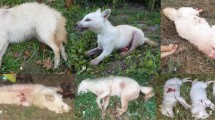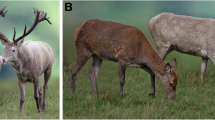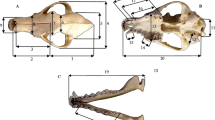Abstract
The use of functional mutations, in addition to standard noncoding molecular markers, can help to detect hybridization and gene introgression in wild canid populations. We analyzed ancestry of a canid pack breeding in Central Italy that showed black coats and other unusual morphological traits suggesting wolf × dog hybrid origins. Individuals were identified by genotyping excremental DNA at 13 autosomal microsatellites, mtDNA control region sequences, a male-specific restriction site on the ZFX/Y gene to determine the gender of the individuals, four Y-linked microsatellites to determine male haplotypes, and two melanistic mutations: a SNP at exon 4 of the Agouti locus and a 3-bp deletion at a β-Defensin gene, the K locus. Results showed that: (1) the pack was founded by a single breeding pair of related individuals, probably brother and sister, and no immigrant was detected; (2) parents and offspring showed signals of admixture at autosomal microsatellites; and (3) the melanistic K locus deletion was present in the black-coated female parent and in 8/14 offspring, but it was absent in the wild type male parent. This deletion was found also in 17/40 village dogs randomly sampled from nearby areas, but it was absent in a random sample of 40 Italian wolves. These findings suggest that the pack received the K locus deletion from dogs. Admixture analyses of empirical and simulated genotypes indicate the parents of the pack originated through a single hybridization event at least two generations back. Genetic and phenotypic assessments of coat color mutations can contribute to investigation of the origin and dynamics of functional polymorphisms in hybridizing wolf populations and to develop appropriate guidelines to contrast hybridization with their domesticated relatives.



Similar content being viewed by others
References
Allendorf FW, Hohenlohe PA, Luikart G (2011) Genomics and the future of conservation genetics. Nat Rew Genetics 11:697–709
Allendorf FW, Leary RF, Spruell P, Wenburg JK (2001) The problems with hybrids: setting conservation guidelines. Trends Ecol Evol 16:613–622
Anderson EC, Thompson EA (2002) A model-based method for identifying species hybrids using multilocus genetic data. Genetics 160:1217–1229
Anderson TM, vonHoldt BM, Candille SI et al (2009) Molecular and evolutionary history of melanism in North American gray wolves. Science 323:1339–1343
Andersone Z, Lucchini V, Randi E, Ozolins J (2002) Relationships between wolves and dogs in Latvia as documented using mitochondrial and microsatellite DNA markers. Mamm Biol 67:79–90
Apollonio M, Mattioli L, Scandura M (2004) Occurrence of black wolves in the Northern Apennine, Italy. Acta Theriol 49:281–285
Arnold ML, Martin SH (2010) Hybrid fitness across time and habitats. Trends Ecol Evol 25:530–536
Barilani M, Sfougaris A, Giannakopoulos A, Mucci N, Tabarroni C, Randi E (2007) Detecting introgressive hybridisation in rock partridge populations (Alectoris graeca) in Greece through Bayesian admixture analyses of multilocus genotypes. Conserv Genet 8:343–354
Barsh GS (2006) Regulation of pigment type switching by Agouti, melanocortin signaling, attractin and mahoganoid. In: Nordlund JJ, Boissy RE, Hearing VJ et al (eds) The pigmentary system. Blackwell, Oxford, pp 395–410
Belkhir K, Borsa P, Chikhi L, Raufaste N, Bonhomme F (1996-2004) GENETIX 4.05, logiciel sous Windows TM pour la génétique des Populations. Laboratoire Génome, Populations, Interactions, CNRS UMR 5000, Université de Montpellier II, Montpellier, France
Benzécri JP (1973) L’analyse des données. Vol 2: L’analyse des correspondances. Dunod, Paris, France
Beja-Pereira A, Oliveira R, Alves PC, Schwartz MK, Luikart G (2009) Advancing ecological understandings through technological transformations in noninvasive genetics. Mol Ecol Resources 9:1279–1301
Boitani L (1983) Wolf and dog competition in Italy. Acta Zool Fenn 174:259–264
Broquet T, Petit E (2004) Quantifying genotyping errors in noninvasive population genetics. Mol Ecol 13:3601–3608
Candille SI, Kaelin CB, Cattanach BM et al (2007) A β-defensin mutation causes black coat colour in domestic dogs. Science 318:1418–1423
Caniglia R, Fabbri E, Cubaynes S, Gimenez O, Lebreton JD, Randi E (2012) An improved procedure to estimate wolf abundance using non-invasive genetic sampling and capture–recapture mixture models. Conserv Genet 13:53–64
Caniglia R, Fabbri E, Greco C, Randi E (2010) Non-invasive genetic monitoring of the wolf (Canis lupus) population in Emilia-Romagna. In: Caniglia R, Fabbri E, Greco C, Randi E (eds) Proceeding of the Conference: scientific research and management for wolf conservation in Italy. Nat Conserv Rep 33, Ministry of Environment-ISPRA, Bologna, Italy, pp 19–66 (in Italian)
Ciucci P, Lucchini V, Boitani L, Randi E (2003) Dewclaws in wolves as evidence of admixed ancestry with dogs. Can J Zool 81:2077–2081
Coulson T, MacNulty DR, Stahler DR, vonHoldt BM, Wayne RK, Smith DW (2011) Modeling effects of environmental change on wolf population dynamics, trait evolution, and life history. Science 334:1275–1278
Easterling MR, Ellner SP, Dixon PM (2000) Size-specific sensitivity: applying a new structured population model. Ecology 81:694–708
Eizirik E, Yuhki N, Johnson WE, Menotti-Raymond M, Hannah SS, O’Brien SJ (2003) Molecular genetics and evolution of melanism in the cat family. Curr Biol 13:448–453
Erles K, Brownlie J (2010) Expression of β-defensins in the canine respiratory tract and antimicrobial activity against Bordetella bronchiseptica. Vet Immunol Immunopathol 135:12–19
Evanno G, Regnaut S, Goudet J (2005) Detecting the number of clusters of individuals using the software Structure: a simulation study. Mol Ecol 14:611–2620
Excoffier L, Hofer T, Foll M (2009) Detecting loci under selection in a hierarchically structured population. Heredity 103:285–298
Fabbri E, Caniglia R, Mucci N, Thomsen HP, Crag K, Pertoldi C, Loeschcke V, Randi E (2012) Comparison of single nucleotide polymorphism and microsatellites in non-invasive genetic monitoring of a wolf population. Arch Biol Sci Belgrade 64:321–335
Fabbri E, Miquel C, Lucchini V, Santini A, Caniglia R, Duchamp C, Weber JM, Lequette B, Marucco F, Boitani L, Fumagalli L, Taberlet P, Randi E (2007) From the Apennines to the Alps: colonization genetics of the naturally expanding Italian wolf (Canis lupus) population. Mol Ecol 16:1661–1671
Falush D, Stephens M, Pritchard JK (2003) Inference of population structure using multilocus genotype data: linked loci and correlated allele frequencies. Genetics 164:1567–1587
Francisco LV, Langston AA, Mellersh CS, Neal CL, Ostrander EA (1996) A class of highly polymorphic tetranucleotide repeats for canine genetic mapping. Mamm Genome 7:359–362
Fredholm M, Winterø AK (1995) Variation of short tandem repeats within and between species belonging to the Canidae family. Mamm Genome 6:11–18
Genovesi P, Dupré E (2000) Strategia nazionale di conservazione del lupo (Canis lupus): indagine sulla presenza e la gestione di cani vaganti in Italia. Biol Cons Fauna 104:1–33 (in Italian)
Godinho R, Llaneza L, Blanco JC et al (2011) Genetic evidence for multiple events of hybridisation between wolves and domestic dogs in the Iberian Peninsula. Mol Ecol 20:5154–5166
Gottelli D, Sillero-Zubiri C, Applebaum GD, Roy MS, Girman DJ, Garcia-Moreno J, Ostrander EA, Wayne RK (1994) Molecular genetics of the most endangered canid: the Ethiopian wolf Canis simensis. Mol Ecol 3:301–312
Guo SW, Thompson EA (1992) Performing the exact test of Hardy–Weinberg proportions for multiple alleles. Biometrics 48:361–372
Hindrikson M, Männil P, Ozolins J, Krzywinski A, Saarma U (2012) Bucking the trend in wolf-dog hybridization: first evidence from Europe of hybridization between female dogs and male wolves. PLoS One. doi:10.1371
Hedrick PW (2009) Wolf of a different colour. Heredity 103:435–436
Hoekstra HE, Krenz JG, Nachman MW (2005) Local adaptation in the rock pocket mouse (Chaetodipus intermedius): natural selection and phylogenetic history of populations. Heredity 94:217–228
Iacolina L, Scandura M, Gazzola A et al (2010) Y-chromosome microsatellite variation in Italian wolves: a contribution to the study of wolf-dog hybridisation patterns. Mamm Biol 75:341–347
Kerns JA, Newton J, Berryere TG et al (2004) Characterization of the dog Agouti gene and a nonagouti mutation in German Shepherd dogs. Mamm Genome 15:798–808
Kerns JA, Cargill EJ, Clark LA et al (2007) Linkage and segregation analysis of black and brindle coat color in domestic dogs. Genetics 176:1679–1689
Kim Y, Maruki T (2011) Hitchhiking effect of a beneficial mutation spreading in a subdivided population. Genetics 189:213–226
Liberg O, Andrén H, Pedersen HC, Sand H, Sejberg D, Wabakken P, Åkesson M, Bensch S (2005) Severe inbreeding depression in a wild wolf (Canis lupus) population. Biol Letters 1:17–20
Longmire JL, Maltbie M, Baker RJ (1997) Use of ‘lysis buffer’ in DNA isolation and its implication for museum collections. Occasional Papers, Museum of Texas Tech University 163:1–3
Lucchini V, Fabbri E, Marucco F et al (2002) Non-invasive molecular tracking of colonizing wolf (Canis lupus) packs in the western Italian Alps. Mol Ecol 11:857–868
Lucchini V, Galov A, Randi E (2004) Evidence of genetic distinction and long-term population decline in wolves (Canis lupus) in the Italian Apennine. Mol Ecol 13:523–536
Marucco F, Boitani L, Pletscher DH, Schwartz MK (2011) Bridging the gaps between non-invasive genetic sampling and population parameter estimation. Eur J Wildl Res 57:1–13
Mech LD, Boitani L (eds) (2003) Wolves: behaviour, ecology and conservation. University of Chicago Press, Chicago
Miller C, Joyce P, Waits L (2002) Assessing allelic dropout and genotype reliability using maximum likelihood. Genetics 160:357–366
Muñoz-Fuentes V, Darimont CT, Paquet PC, Leonard JA (2010) The genetic legacy of extirpation and re-colonization in Vancouver Island wolves. Conserv Genet 11:547–556
Musiani M, Leonard JA, Cluff HD et al (2007) Differentiation of tundra/taiga and boreal coniferous forest wolves: genetics, coat colour and association with migratory caribou. Mol Ecol 16:4149–4170
Nielsen EE, Bach LA, Kotlicki P (2006) HYBRIDLAB (version 1.0): a program for generating simulated hybrids from population samples. Mol Ecol Notes 6:971–973
Oliveira R, Godinho R, Randi E, Alves PC (2008) Hybridization versus conservation: are domestic cats threatening the genetic integrity of wildcats (Felis silvestris silvestris) in Iberian Peninsula? Phil Trans R Soc B 363:2953–2961
Ostrander EA, Sprague GF, Rine J (1993) Identification and characterization of dinucleotide repeat (CA)n markers for genetic mapping in dog. Genomics 16:207–213
Pazgier M, Hoover DM, Yang D, Lu W, Lubkowski J (2006) Human β-defensins. Cell Mol Life Sci 63:1294–1313
Peakall R, Smouse PE (2006) GenAlEx v. 6.1: genetic analysis in Excel. Population genetic software for teaching and research. Mol Ecol Notes 6:288–295
Randi E (2008) Detecting hybridisation between wild species and their domesticated relatives. Mol Ecol 17:285–293
Randi E, Lucchini V (2002) Detecting rare introgression of domestic dog genes into wild wolf (Canis lupus) populations by Bayesian admixture analyses of microsatellite variation. Conserv Genet 3:29–43
Randi E, Lucchini V, Christensen MF et al (2000) Mitochondrial DNA variability in Italian and east European wolf: detecting the consequence of small population size and hybridisation. Conserv Biol 14:464–473
Rees JL (2003) Genetics of hair and skin colour. Annu Rev Genet 37:67–90
Rhymer JM, Simberloff D (1996) Extinction by hybridisation and introgression. Annu Rev Ecol System 27:29–44
Rice WR (1989) Analyzing tables of statistical tests. Evolution 43:223–225
Rousset F (2008) Genepop’007: a complete reimplementation of the Genepop software for Windows and Linux. Mol Ecol Resources 8:103–106
Smith D, Meier T, Geffen E, Mech DL, Burch JW, Adams LG, Wayne RK (1997) Is incest common in gray wolf packs? Behav Ecol 8:384–391
Sundqvist AK, Ellegren H, Olivier M, Vilà C (2001) Y chromosome haplotyping in Scandinavian wolves (Canis lupus) based on microsatellite markers. Mol Ecol 10:1959–1966
Vähä JPK, Primmer CR (2006) Detecting hybridisation between individuals of closely related populations—a simulation study to assess the efficiency of model-based Bayesian methods to detect hybrid individuals. Mol Ecol 15:63–72
Valière N (2002) Gimlet: a computer program for analysing genetic individual identification data. Mol Ecol Notes 2:377–379
Verardi A, Lucchini V, Randi E (2006) Detecting introgressive hybridisation between free-ranging domestic dogs and wild wolves (Canis lupus) by admixture linkage disequilibrium analysis. Mol Ecol 15:2845–2855
Vilà C, Wayne RK (1999) Hybridisation between wolves and dogs. Conserv Biol 13:195–198
Vilà C, Walker C, Sundqvist A-K et al (2003) Combined use of maternal, paternal and bi-parental genetic markers for the identification of wolf-dog hybrids. Heredity 90:17–24
vonHoldt BM, Pollinger JP, Earl DA et al (2011) A genome-wide perspective on the evolutionary history of enigmatic wolf-like canids. Genome Res 21:1294–1305
Waits LP, Luikart G, Taberlet P (2001) Estimating the probability of identity among genotypes in natural populations: cautions and guidelines. Mol Ecol 10:249–256
Wang J, Santure AW (2009) Parentage and sibship inference from multilocus genotype data under polygamy. Genetics 181:1579–1594
Weir BS, Cockerham CC (1984) Estimating F-statistic for the analysis of population structure. Evolution 38:1358–1370
Acknowledgments
We warmly thank everybody who made it possible to realize this research project and who contributed to obtain samples used in this study, in particular: G. P. Sammuri (President of the Maremma Regional Park), M. Aloisi that kindly helped in collecting most of the dog blood samples, and L. Rigacci for the pictures. P. Ciucci kindly commented on an early version of the manuscript. The project was supported by the Italian Ministry of Environment, Direction of Nature Protection, and by the Tuscany Region through the Maremma Regional Park. We are particularly grateful to the EJWR Associated Editor and two anonymous referees for their constructive comments and insightful ideas that helped to deeply improve an early version of this manuscript.
Author information
Authors and Affiliations
Corresponding author
Additional information
Communicated by C. Gortázar
Electronic supplementary material
Below is the link to the electronic supplementary material.
ESM 1
Pictures showing the phenotype of some members of the canid pack living in the Maremma Regional Park (courtesy of L. Rigacci). (PDF 234 kb)
ESM 2
Assignment test of the individuals of uncertain origin. (PDF 29 kb)
ESM 3
List of the 16 distinct individual genotypes (F female, M male) sampled in the Maremma Regional Park (MRP) pack as determined at: 13 unlinked STRs, K locus, Agouti locus, four Y-STRs, and control region of mtDNA. (PDF 31 kb)
Rights and permissions
About this article
Cite this article
Caniglia, R., Fabbri, E., Greco, C. et al. Black coats in an admixed wolf × dog pack is melanism an indicator of hybridization in wolves?. Eur J Wildl Res 59, 543–555 (2013). https://doi.org/10.1007/s10344-013-0703-1
Received:
Revised:
Accepted:
Published:
Issue Date:
DOI: https://doi.org/10.1007/s10344-013-0703-1




